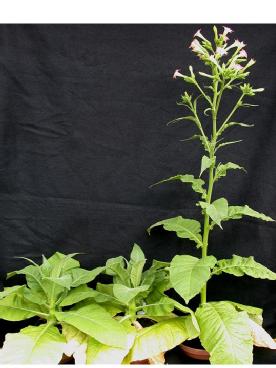Virus-induced flowering
Together with Prof Yiguo Hong at the Research Centre for Plant RNA Signalling, Hangzhou Normal University in China, we are investigating the potential to use disabled virus vectors to deliver floral inducing signals into plants in order to make them flower at a specific time.
In the picture below we have used Potato Virus X (PVX) which is expressing the FT gene (PVX/FT) or a non-functional mutated version of the FT gene (PVX/mFT) to infect Maryland Mammoth tobacco plants. Maryland Mammoth tobacco require short days in order to flower, these plants have been grown in non-inductive long day conditions and so would not normally flower (see the mock-inoculated control plant on the left).
Expression of the FT gene from the PVX virus in the plant causes induction of flowering in non-inductive conditions (plant on right), and this is due to the FT gene because if the FT gene is mutated there is no flowering (middle).

Mock Inoculated PVX/mFT PVX/FT
For further information see:
Li, C. et al. (2009). A cis-element within FLOWERING LOCUS T mRNA determines its mobility and facilitates trafficking of heterologous viral RNA. J.Virology 83:3540-3548. (Faculty of 1000 Biology).
Li, C., Gu, M., Shi, N., Zhang,H., Yang, X., Osman, T., Liu,Y., Wang, H., Vatish, M., Jackson, S. & Y.Hong (2011). Mobile FT mRNA contributes to the systemic florigen signaling in floral induction. Scientific Reports 1: 73. (Research highlight by Nature Middle East, doi:10.1038/nmiddleeast.2011.123).
Qin C, Chen W, Shen J, Cheng L, Akande F, Zhang K, Yuan C., Li C, Zhang P, Shi N, Cheng Q, Liu Y, Jackson S and Y Hong (2017). A Virus-induced Assay for Functional Dissection and Analysis of Monocot and Dicot Flowering Time Genes. Plant Physiol. 174: 875-885. DOI: 10.1104/pp.17.00392
